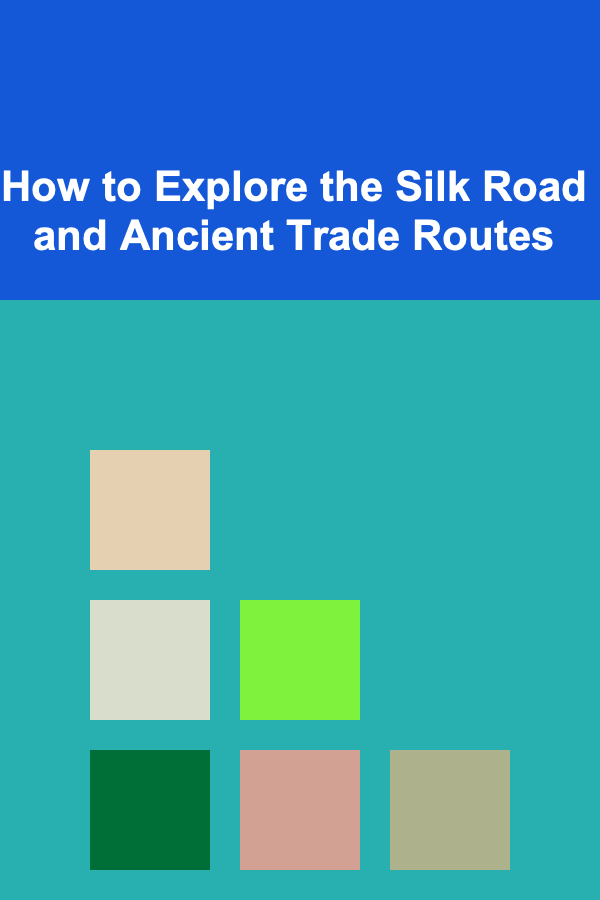
How to Explore the Silk Road and Ancient Trade Routes
ebook include PDF & Audio bundle (Micro Guide)
$12.99$10.99
Limited Time Offer! Order within the next:

The Silk Road is one of the most iconic trade routes in history, symbolizing the interconnectedness of civilizations and cultures across vast expanses of land. Stretching over 4,000 miles from China to the Mediterranean, the Silk Road enabled the exchange of goods, ideas, cultures, and technologies between the East and West. While the term "Silk Road" is most commonly associated with the exchange of silk, it was a route that carried a diverse array of commodities, such as spices, precious metals, textiles, and even knowledge.
Exploring the Silk Road is more than just a journey through time and geography. It is an opportunity to dive deep into the rich historical, cultural, and economic tapestry that shaped the modern world. In this article, we will explore how to approach the exploration of the Silk Road and its ancient trade routes, taking into account its historical significance, the modern-day opportunities for exploration, and how one can retrace these paths to better understand the global connections of the past.
Understanding the Silk Road: Historical Context
Before embarking on an exploration of the Silk Road, it's essential to understand its origins and historical context. The Silk Road wasn't just one single route, but rather a complex network of trade paths, both over land and by sea, that connected the East with the West for over 1,500 years. It emerged during the Han Dynasty in China around the 2nd century BCE and thrived for centuries under different empires, such as the Roman Empire, the Byzantine Empire, and the Mongol Empire.
The Silk Road was not solely about trade; it was also a conduit for cultural and technological exchanges. As merchants and travelers journeyed along the routes, they carried with them not just goods, but also philosophies, religious beliefs, languages, and artistic traditions. The spread of Buddhism from India to China, the introduction of paper-making techniques from China to the West, and the blending of various culinary traditions are just a few examples of the profound cultural exchanges that took place along the Silk Road.
The Main Routes
The overland Silk Road can be divided into two main routes:
- The Northern Route: This route passed through Central Asia and connected China to the Mediterranean via cities like Samarkand and Bukhara. It was characterized by vast deserts, high mountain ranges, and challenging landscapes.
- The Southern Route: Passing through the Taklamakan Desert and the Iranian Plateau, this route was often more direct and provided access to key cities in India and the Middle East. It was a crucial passage for the movement of goods like spices, textiles, and ivory.
Additionally, there were maritime routes, known as the "Maritime Silk Road," which connected ports in Southeast Asia, India, and East Africa. These sea-based routes were instrumental in the trade of goods like porcelain, tea, and precious stones.
The Cultural Impact of the Silk Road
The Silk Road's impact extended far beyond the physical exchange of goods. It was a cultural melting pot, where people from diverse backgrounds met, interacted, and exchanged ideas. Some of the most important cultural exchanges include:
- Religion: Buddhism spread from India to China through the Silk Road, influencing East Asian culture and religious practices. Other religions, including Zoroastrianism, Christianity, and Islam, also traveled along these routes.
- Art and Architecture: The artistic traditions of the East and West influenced each other, seen in the Greco-Buddhist art of Central Asia and the fusion of Persian and Chinese architectural styles.
- Science and Technology: Innovations like papermaking and gunpowder traveled from China to the West, while the ancient world's knowledge of astronomy, mathematics, and medicine found its way to China and India.
Thus, exploring the Silk Road is not just a journey through the landscape, but also an intellectual voyage that reveals the mutual influences between distant civilizations.
Modern Exploration of the Silk Road
Today, the legacy of the Silk Road can still be explored through historical sites, ancient cities, and the modern infrastructure that crisscrosses the same routes. The journey along the Silk Road offers a chance to experience firsthand the cultures that once thrived there, explore the ruins of ancient cities, and visit modern-day countries that were once the hub of trade and commerce.
3.1 Visiting Ancient Cities Along the Silk Road
Many cities that played pivotal roles in the Silk Road's history still stand today, serving as vibrant testimonies to the route's former glory. Among these are:
- Xi'an, China: Often considered the starting point of the Silk Road, Xi'an was the capital of several Chinese dynasties, including the Tang Dynasty. The city is home to the famous Terracotta Army and the Big Wild Goose Pagoda, which housed many Buddhist scriptures.
- Samarkand, Uzbekistan: A key stop on the Silk Road, Samarkand was a cultural and intellectual center under the Timurid Empire. Today, visitors can marvel at the stunning architecture of Registan Square and the Shah-i-Zinda necropolis, showcasing the rich Islamic heritage of the region.
- Bukhara, Uzbekistan: Known as the "City of Museums," Bukhara retains many of its ancient mosques, madrassas, and caravanserais. Its old town, a UNESCO World Heritage site, is a living museum of the Silk Road.
- Merv, Turkmenistan: Once one of the largest cities in the world, Merv was a major trading hub and an important stop on the Silk Road. Its ruins are a testament to the grandeur of ancient civilizations.
- Persian Cities: Cities like Tehran, Isfahan, and Yazd in Iran were crucial points of exchange for trade and culture, where Persian, Arabic, and Central Asian influences converged.
3.2 Traveling by the Silk Road Today
Exploring the Silk Road today often requires a combination of modern transportation and the willingness to venture off the beaten path. Many travel agencies and tour operators offer curated Silk Road tours that allow travelers to experience the key destinations along the route. While the journey can be challenging, particularly when traversing remote desert regions or rugged mountains, it is a deeply rewarding experience for history buffs, adventure seekers, and cultural enthusiasts alike.
Moreover, technological advancements, such as improved rail systems, high-speed trains, and digital tools for mapping ancient routes, have made it easier to navigate the vast expanse of the Silk Road. With better connectivity between China, Central Asia, and the Middle East, traveling these historic paths has become a more accessible venture.
The Impact of Modern Trade Routes on the Legacy of the Silk Road
The modern-day trade routes, such as the Belt and Road Initiative (BRI), are often seen as a revival of the ancient Silk Road. Initiated by China in 2013, the BRI aims to improve infrastructure and trade connections between Asia, Europe, and Africa, echoing the spirit of the ancient Silk Road. However, these modern trade routes have a different focus, prioritizing the movement of capital and goods over the cultural exchanges that once defined the original Silk Road.
Nonetheless, the BRI draws heavily on the history of the ancient trade routes, emphasizing economic growth, regional cooperation, and cross-cultural collaboration. While the BRI focuses on contemporary needs, it still invokes the historical significance of the Silk Road as a means of fostering connection between East and West.
4.1 The Role of Technology in Rediscovering the Silk Road
Today, technology plays an essential role in preserving the history and memory of the Silk Road. Digital archives, virtual museums, and interactive maps allow individuals from all over the world to explore and learn about the Silk Road without leaving their homes. Moreover, modern-day archaeologists and historians continue to uncover ancient relics and settlements, shedding light on the vast networks of trade, culture, and ideas that spanned from China to the Mediterranean.
Virtual reality (VR) technology, in particular, offers a groundbreaking way to experience the ancient Silk Road in an immersive and interactive way. For instance, VR tours allow users to explore historical sites like the ancient city of Palmyra in Syria or the Buddhist caves of Dunhuang in China, which are important landmarks on the Silk Road.
Reconnecting with the Ancient Trade Routes
Exploring the Silk Road and its ancient trade routes isn't just about retracing the steps of ancient merchants. It's about engaging with the lasting legacies of cross-cultural interactions, gaining insight into the birth of globalization, and learning how trade and travel shaped the world as we know it today.
While the Silk Road's trade networks may no longer exist in the same form, the lessons learned from this ancient route are as relevant today as ever. The Silk Road was a symbol of connectivity, adaptability, and cultural exchange. As we navigate our modern world, we can draw inspiration from the enduring spirit of collaboration that the Silk Road embodied.
Conclusion
The Silk Road was much more than just a series of trade routes---it was a cultural and intellectual bridge between the East and West, facilitating the exchange of ideas, technologies, and goods. Exploring the Silk Road today offers an opportunity to connect with our shared human heritage and understand the forces that shaped the interconnected world we live in.
Whether you're traveling along the ancient paths or exploring them through digital means, the Silk Road remains an enduring symbol of human curiosity, resilience, and cooperation. By retracing these routes, we gain not only a deeper understanding of history but also insight into the possibilities for a future where global cooperation and exchange continue to flourish.

How to Maintain a Clean Home While Working From Home
Read More
How To Organize Your Home with Minimalist Principles
Read More
How to Set Up a Command Center for Family Management
Read More
How to Practice Sound Healing and Vibration Therapy
Read More
Fostering Lifelong Intercultural Connections
Read More
How to Understand Credit Card Cash Advance Fees
Read MoreOther Products

How to Maintain a Clean Home While Working From Home
Read More
How To Organize Your Home with Minimalist Principles
Read More
How to Set Up a Command Center for Family Management
Read More
How to Practice Sound Healing and Vibration Therapy
Read More
Fostering Lifelong Intercultural Connections
Read More